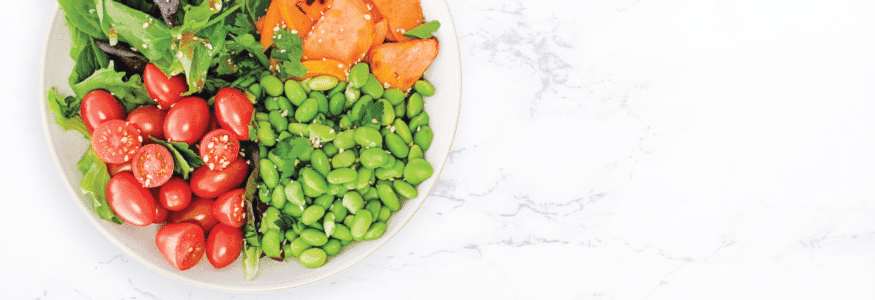
Plant-Based Low FODMAP Diet
Plant-based diet
What do oranges, almonds, basil, and olives all have in common? They’re all plants. This article will discuss what a plant-based diet is, how to eat a plant-based low FODMAP diet, and practical tips and strategies to get more plants into your diet, whether you’re following a low FODMAP diet or not.
A plant-based diet is a diet where you eat plants most of the time. It means that the majority of the foods you eat are plants, sometimes with a bit of meat or dairy here and there. It does not mean that you must be vegetarian or vegan, although those are plant-based diets too. The focus is on eating and enjoying plenty of vegetables, nuts, seeds, legumes, whole grains, and fruit.
Everyone can benefit from eating more plants. If you love meat, you can still eat more plants. If you love dairy, you can still eat more plants. Even if you hate vegetables (trust me, this happens), you can still eat at least one plant a day, even if it is in the form of guacamole. Your healthy gut bacteria thrive off plants, and what benefits them benefits you.
It is amazing how much more interesting and flavourful life becomes when you start to discover the creative combinations that arise from eating this way. For example, toasted hazelnuts on a lemony kale salad with chunks of grapefruit, or roasted carrots drizzled with tahini, thyme, and a touch of maple syrup. What about preserved lemons, hummus, raw sauerkraut, sundried tomatoes, mutabal (eggplant dip), or lahpet (fermented tea leaf salad)? Never has my mouth burst with so many stimulating flavors. I hope yours will too.
Low FODMAP diet
The low FODMAP diet is an effective strategy to reduce and control gut symptoms such as abdominal pain, bloating, and diarrhea for people with irritable bowel syndrome (IBS).1 It is a complex dietary strategy that has been shown to be successful with the help and guidance of a registered dietitian.2 It’s important to have as many meal ideas, brands, and recipes as possible, and knowing what to look for in a food label is key. It simply isn’t good enough to be given a food list.
Yes, it can be a challenge to eat a plant-based low FODMAP diet, but it’s possible. All it takes is a little planning. It’s important to know that the elimination part of the diet is short-term (2-8 weeks), and there will be more options to choose from after that. The five nutrients to focus on getting enough of are calcium, iron, protein, vitamin B12, and zinc.3 The following lists are plant-based low FODMAP foods to enjoy daily to maximize your nutrient intake and optimize your gut health.
Calcium
- fortified plant beverages: almond, rice, soy, quinoa, hemp, macadamia
- collard greens
- tofu, firm, plain, with calcium
- tempeh, plain, with calcium
- almonds (<10 = low FODMAP)
- kale
- bok choy
- chia seeds
- broccoli
- orange
Iron
- quinoa
- pumpkin seeds
- teff
- oatmeal: instant, fortified
- buckwheat groats
- cornmeal
- sorghum
- spinach
- sesame seeds
- tofu, firm, plain
- tempeh, plain
- bok choy
- pine nuts
- swiss chard
- sunflower seeds
- edamame
Protein
- buckwheat groats
- oats, rolled
- teff
- quinoa: grain, flakes, pasta
- nuts: almonds, hazelnuts, peanuts, brazil nuts, pine nuts, walnuts
- seeds: chia, poppy, pumpkin, sesame, sunflower
- nut and seed butter: peanut, almond, pumpkin, sunflower
- rice protein powder
- 100% pea protein isolate
- spirulina
- edamame
- miso paste
- tofu, firm, plain
- tempeh, plain
- soy beverage (made from soy protein, no inulin)
Vitamin B12
- fortified plant beverages: almond, rice, soy, quinoa, hemp, macadamia
- fortified nutritional yeast
Zinc
- pumpkin seeds
- tofu, firm, plain
- tempeh, plain
- nuts: pine, peanuts, almonds (<10 = low FODMAP)
- sunflower seeds
- wild rice
Ten ways to eat more plants on a low FODMAP diet
- Bake: low FODMAP breakfast cookies and store in the freezer for a quick breakfast, no morning prep required. Find buckwheat breakfast cookies at modernguthealth.com.
- Blend one cup of spinach (or kale) into one to two cups of almond, rice, or hemp beverage. Use in hot cereals, granola, pancakes, crepes, muffins, smoothies or curries.
- Cereal: add ½ cup shredded carrots or zucchini to hot cereal (oatmeal, buckwheat, teff, millet, quinoa, cream of rice) or overnight oats with cinnamon and maple syrup.
- Chips: make crispy baked vegetable chips: carrots, kale, parsnips, plantains, potatoes.
- Granola: Make a double batch of low FODMAP granola in less than 30 minutes. Check out my recipe at com.
- Grate: use the attachment on your food processor that grates vegetables in seconds. Try carrots, cucumber, or zucchini and store in the fridge for use during the week to make an easy salad.
- Grind: low FODMAP nuts and seeds into a powder to make your own protein powder that can be added to cereals, yogurt, smoothies, soups, or to replace bread crumbs.
- Pesto: Use leftover greens (spinach, arugula, kale, parsley, cilantro, mint), low FODMAP nuts (walnut or pine), and replace the garlic with garlic-infused oil. You can substitute parmesan with nutritional yeast too. Freeze in ice cube trays. Check out my recipe at modernguthealth.com.
- Sauté: take 1-2 minutes to sauté low FODMAP greens like spinach and kale, and 8-10 minutes for bok choy and collard greens. Flavour with soy sauce or tamari.
- Spiralize: zucchini noodles are fun to eat hot or cold. Try it with pesto and cherry tomatoes.

Build-your-own low FODMAP bowl
- Choose one protein, one starch, and one to two vegetables
- Top with easy low FODMAP dressing
- Throw in some extras if you feel like it
| Protein | Starch | Vegetable |
| chia seeds (2 tbsp) | acorn squash, roasted (1 cup) | arugula (1 cup) |
| edamame
(½-1 cup) |
buckwheat groats
(3/4 cup cooked) |
broccoli
(1 cup cooked) |
| peanuts (¼ cup) | millet (1 cup cooked) | bok choy (1 cup cooked) |
| poppy seeds (2 tbsp) | plantain, (1 medium) | carrots (1 cup raw or cooked) |
| pumpkin seeds (1/4 cup) | polenta, cornmeal (1 cup cooked) | cucumber (1 cup) |
| sesame seeds (2-4 tbsp) | potato, roasted (1 cup) | eggplant (½ -1 cup) |
| sunflower seeds (¼ cup) | rice (1 cup cooked) | kale or lettuce (1 cup) |
| tempeh, plain (150 g) | rice noodles (1 cup cooked) | parsnips (1 cup) |
| tofu, firm, plain (150 g) | quinoa (1 cup cooked) | spinach (1 cup) |
| walnuts (¼-½ cup) | yam, roasted (¾ cup) | tomato, (1-2 medium) |
| Dressing | ||
| 1. mix oil, vinegar, and a pinch of salt and pepper in a jar
2. add optional add-ins if you feel like it 3. store leftovers in the fridge |
||
| oil (3 tbsp) | vinegar (1 tbsp) | optional (1-2 tsp) |
| avocado | apple cider vinegar | almond butter |
| canola | balsamic vinegar | Dijon mustard |
| grapeseed | red wine vinegar | lemon juice or zest |
| olive | rice wine vinegar | maple syrup |
| sesame | white wine vinegar | miso paste |
| Extras | ||
| basil, parsley, mint | nutritional yeast flakes | sambal oelek (no garlic) |
| cilantro | orange slices (½ cup) | soy sauce |
| ginger | pesto (no garlic/onion) | spices (cumin, turmeric) |
| gomasio | pineapple (½ cup) | tamari |
| kiwi pineapple salsa | papaya chunks (½ cup) | toasted nori seaweed |
